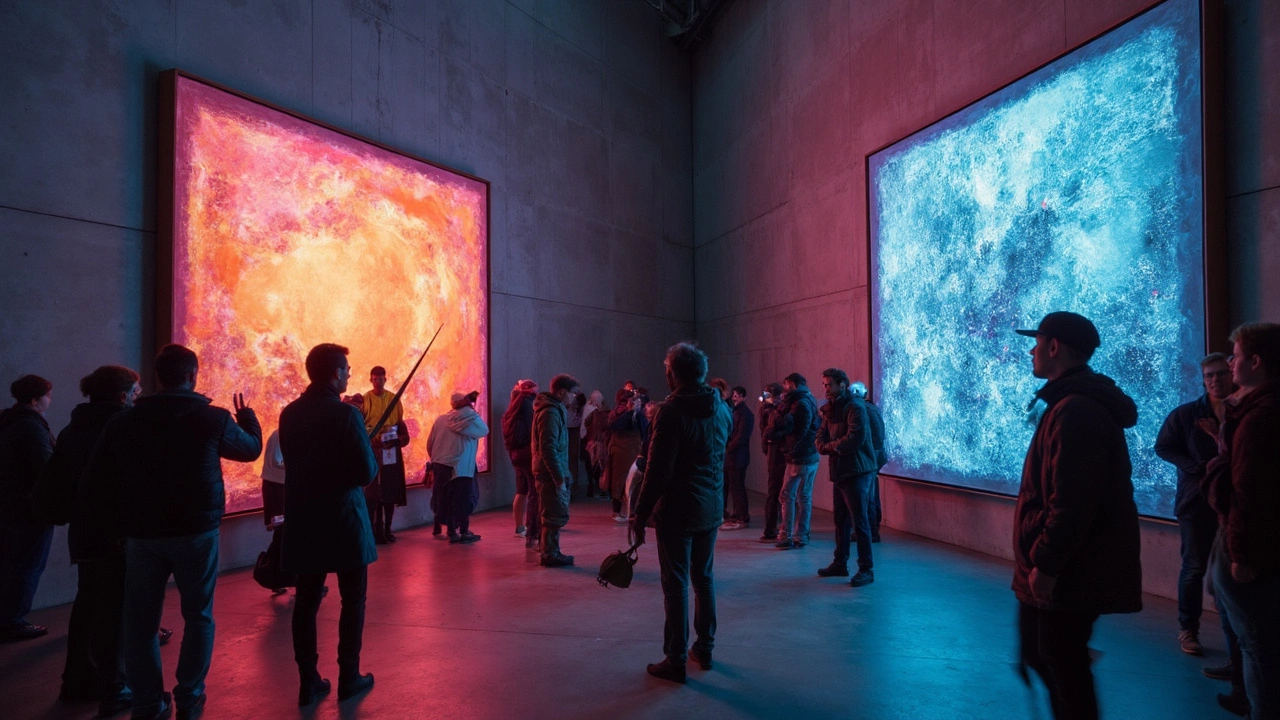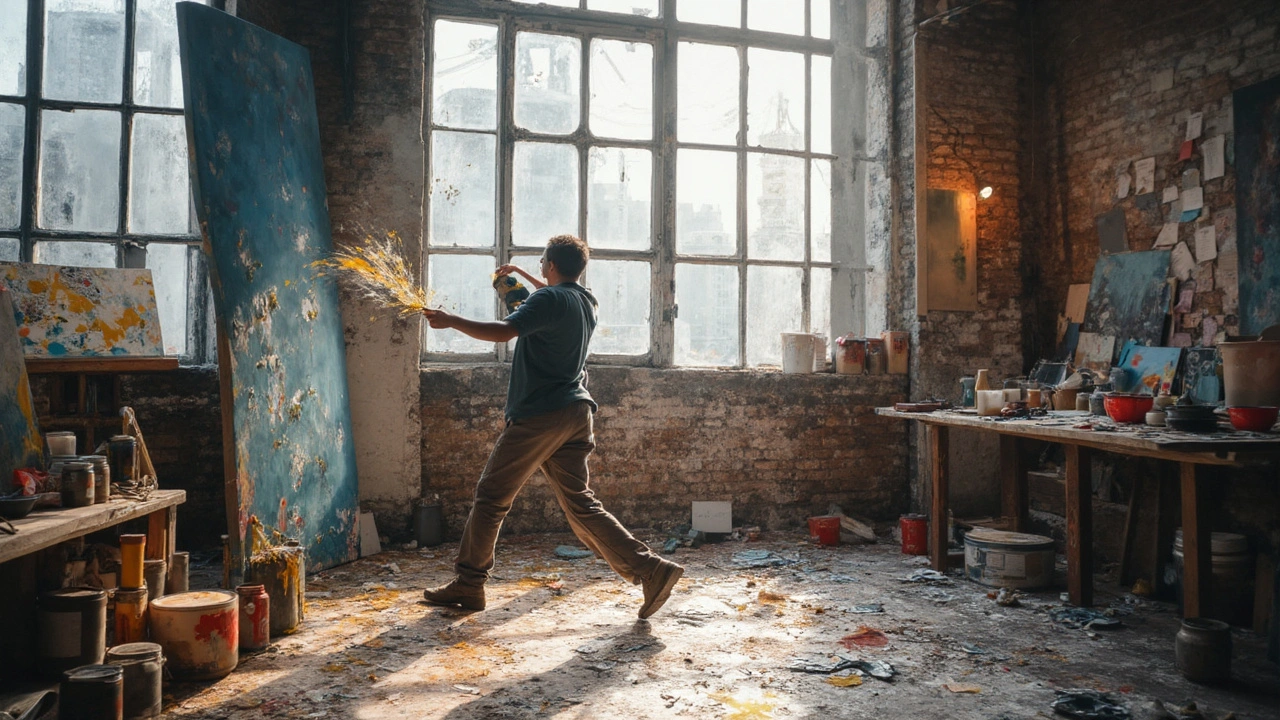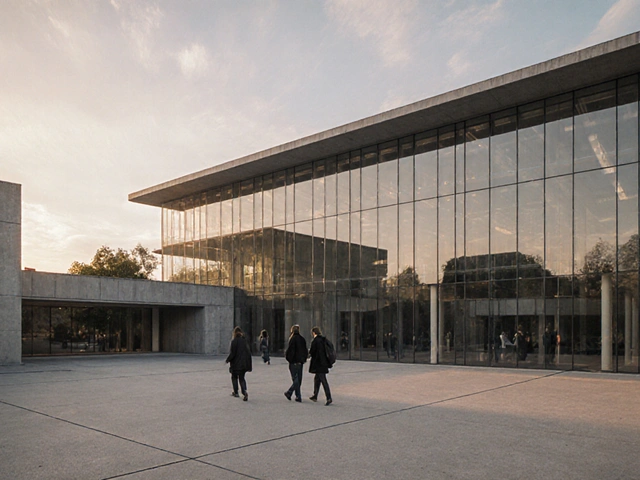If you want a straight answer, here it is: the biggest ideas that remade painting in mid‑century New York-gesture, scale, process, and risk-still drive the way much of contemporary art is made, shown, and valued. We aren’t just talking drips and big canvases. We’re talking performance folded into painting, materials pushed to breaking points, and digital tools that chase the same urgency AbEx painters fought for in the studio. That’s the through-line. This piece maps the practical ways those ideas show up now, from museum floors to your own studio.
TL;DR / Key takeaways:
- Core AbEx traits-gesture, scale, process, chance-are now cross‑disciplinary tools in painting, performance, installation, and digital practice.
- The market, museums, and MFA programs still reward AbEx‑derived strategies: big impact, embodied making, and material risk.
- Contemporary artists borrow AbEx energy without copying the look: think poured resin, AI‑assisted composition, or paint used like choreography.
- To spot the influence, track the method (how the work was made), not the style (how it looks).
- Use the included checklists and table to analyze works, write stronger wall texts, or build your studio process.
Why the AbEx playbook still runs the game
Start with the fact that Abstract Expressionism flipped the hierarchy: the act of making became the content. That single shift-process as meaning-still shapes how we read contemporary art. When artists swing paint, scrape, pour, stitch, or code with obvious physicality, the method carries emotion, time, and chance. The canvas (or screen, or floor) reads like a diary of decisions.
Scale is the second anchor. When a work is larger than you are, your body has to negotiate it. That’s why you’ll see wall‑spanning color fields echoed in today’s installation painting, projection mapping, and fabric hangings. Big work claims public space and attention. It also changes behavior: viewers stand back, then inch closer, scanning marks like they’re reading weather.
Third, risk and improvisation keep the work alive. AbEx painters kept the “accident” as a collaborator; now you’ll see that in performance painting, kiln‑stressed ceramics, glitch‑friendly code, and poured polymers that never quite behave. When the process can fail, meaning feels earned.
Museums and schools codified this legacy. MoMA’s rehanging since 2019 shows AbEx alongside global peers to underline method over style. Tate Modern’s 2016 “Abstract Expressionism” tracked the network beyond New York. In the U.S., MFA critiques still ask the classic questions: where’s the body in this? what can the material do? what decisions are visible? Those are AbEx questions wearing new shoes.
And yes, the market notices. Auction houses reliably place major AbEx works among the top lots, and the postwar and contemporary segment-per the Art Basel & UBS Art Market Report 2025-remains the engine of global sales. Even when tastes swing, collectors stay drawn to works that stage risk in real time. That preference filters down to younger artists who learn that ambition and process read well in a public space or a white cube.
How AbEx ideas translate into contemporary practice
If you want to see the influence without getting stuck on drips and splashes, translate the original traits into practical lenses you can carry into any gallery.
- Gesture becomes choreography: Think bodies moving paint, but also plotters, drones, or robotic arms “performing” mark‑making.
- Scale becomes immersion: Murals, wraparound projections, environmental textiles-work you don’t just view, you enter.
- Process becomes content: Material tests, studio residue, time‑based layers, and documentation folded into the final piece.
- Color field becomes atmosphere: Huge bands of color remixed as gradients, light installations, or layered resin that traps luminosity.
- Chance becomes collaboration: Pouring, cracking, warping, glitching-letting gravity, chemistry, and software randomness co‑author.
Try this quick method on any new show:
- Track the verbs. Pour, weld, sand, scrim, code, loop, stretch. Verbs tell you the piece’s heartbeat.
- Clock the body. Where do you stand? How does your breathing change? Do you need to move to read the work?
- Find the risk. What could have gone wrong? Where did the artist accept imperfection, and why?
- Read the time. Are layers built over weeks, or is there a single decisive sweep?
- Separate look from logic. Two flat fields of color can have opposite meanings if one is meditative and the other is a speed record of decisions.
For artists, the translation is even more hands-on. AbEx isn’t a style to imitate; it’s a set of permissions: go bigger than feels safe, let materials talk back, leave your decisions visible. That applies to paint, sure, but also to concrete, wax, LED panels, 3D prints, and machine learning models.
Case studies: where the echo is clear without feeling derivative
Names help, but keep your eye on patterns. Here are a few contemporary currents that carry the AbEx spark.
- Material maximalists in painting: Big canvases built with squeegees, brooms, and pours; surface as battlefield. The kinship with post‑war action painting is obvious, but the palettes skew neon, the mediums include latex, epoxy, and UV‑cured inks, and the logic nods to urban space and screens.
- Color as environment: Light artists and painters turned installation builders extend color fields into rooms you can walk through. Think gelled light, fog, gradient vinyl, or giant dyed fabric. The emotion of pure color is intact; the delivery system is new.
- Performance‑inflected studios: Artists who paint live during residencies, stream their process, or fold footage into the final work. The studio becomes a stage, and that’s straight from the AbEx emphasis on presence.
- Digital action painting: Tablets and generative tools used to simulate or subvert gesture. “Brushes” become code. Some artists feed accelerometer data or motion‑capture into painting algorithms-same obsession with movement, different toolset.
- Architectural scale: Murals and public art programs commission building‑sized pieces that deliver the same physical encounter AbEx once reserved for the museum. The audience is the street.
Here in Portland, the legacy is surprisingly local: Mark Rothko spent formative years in this city, and the planned Rothko Pavilion at the Portland Art Museum underscores how a color‑first ethos still anchors how we show art. Walk our galleries and you’ll see: many “new” abstract shows are really about presence, scale, and risk-AbEx traits in contemporary clothing.
Institutional signals back this up. The Met’s multi‑year “Epic Abstraction” project reframed the mid‑century canon around scale and experimentation, then pulled contemporary artists into the conversation. MoMA’s current floor plan keeps gestural and material experiments in dialogue with global approaches. These choices teach the public to read process as content, which keeps AbEx’s core alive without freezing it in time.

What to look for: a field guide, a table, and two short checklists
Use this as a pocket map when you’re writing wall text, deciding what to collect, or just trying to get your bearings in a big show.
| AbEx Trait | Contemporary Translation | Typical Materials/Tech | What to Look For |
|---|---|---|---|
| Gesture (visible action) | Choreography, motion‑captured marks | Brooms, squeegees, drones, plotters, motion data | Marks that map movement; rhythm you can “hear” with your eyes |
| Scale (bigger than body) | Immersive walls, wraparound installations | Murals, printed vinyl, projection, textiles | You physically reposition; edges exceed your field of view |
| Process as content | Time‑based layering, visible edits, studio residue | Resin pours, sanded layers, stitched canvases, logs | Decisions left in; the history of making is legible |
| Color field (emotion via color) | Light, gradient, pigment saturation | LEDs, gels, fog, dye, translucent mediums | Atmosphere changes your mood before you analyze |
| Chance and risk | Glitch, crack, warp, pour, heat | Chemical reactions, kiln stress, code randomness | Controlled accidents; the piece “negotiates” with gravity/time |
| Authorship | Collaboration, collectives, co‑authored systems | Shared canvases, datasets, open source tools | Signatures shift to systems; credit is distributed |
Checklist: analyzing a contemporary work with an AbEx lens
- Method: Can you list the verbs that made this? (Pour, sand, weld, code, buff.)
- Time: Is it built in one breath or across months? What reveals the timeline?
- Body: Where is the maker’s body evident-reach, sweep, weight, pause?
- Risk: What could have failed? Why keep that risk visible?
- Scale: How does your position shift as you look? What do you miss from far away?
- Color: Does color carry mood alone, or is it anchored to form/story?
- Evidence: Are edits and seams left in to tell the making story?
Checklist: pitfalls to avoid in reading influence
- Don’t mistake size for substance. Big is a tool, not a virtue.
- Don’t confuse surface drama with depth. Look for decisions, not just effects.
- Don’t freeze history. AbEx was never one look; it was a set of arguments.
- Don’t ignore context. Many contemporary artists complicate AbEx with identity, politics, or ecology-new stakes, new readings.
Quick heuristics that help in the wild:
- The three‑glance rule: one glance for composition, one for method, one for time.
- The six‑foot test: if the piece doesn’t change at six feet, three feet, and six inches, it’s probably relying on spectacle.
- The smudge question: if a “mistake” is left in, assume it’s there to teach you how the work was made.
From studio to market: applying AbEx lessons without pastiche
If you’re making work, here’s a simple framework to borrow the engine without copying the car.
Studio framework (adapt it to paint, clay, code, textile):
- Set one constraint that amplifies your body. Use a tool bigger than your hand, or a gesture that requires your whole arm. If you’re digital, map wrist or body motion to a parameter.
- Increase the stakes. Pick one variable you can’t fully control-drying time, pour viscosity, code randomness-and let it surprise you.
- Leave seams visible. Keep a patch, a sand‑through, a code artifact. Teach the viewer how the piece was built.
- Design for two distances. Make sure the work holds from across the room and within arm’s length.
- Write a process note after each session. Two sentences about what decisions mattered. This is your wall text seed.
If you collect or curate, similar logic applies. Ask: does the work advertise virtuosity, or does it document a search? Pieces aligned with AbEx’s best lessons tend to carry their making forward-so they stay readable years later. That readability supports educational programming and, yes, market durability.
On the market side, the data points are public enough to guide expectations without getting breathless. New records for postwar masters pop up on a regular cadence, while museum retrospectives keep the narrative fresh. Private sales of iconic works remind us that ambition plus process can sustain long arcs of attention. For contemporary makers, that’s not a promise of price-it’s a signal that audiences still crave the drama of decisions.
Citations worth knowing if you write or teach: the Art Basel & UBS Art Market Report 2025 for macro trends; MoMA’s ongoing collection rehang for method‑first curating; Tate Modern’s 2016 “Abstract Expressionism” for historical breadth; and the Met’s “Epic Abstraction” for scale as thesis. If you need named sale benchmarks, look up Jackson Pollock’s 2021 auction record and the high‑profile private sales around de Kooning and Rothko in the last decade; they’ve been widely reported by major auction houses.
FAQ and next steps for artists, students, educators, and collectors
Mini‑FAQ
Is abstraction the only place to see AbEx’s influence?
No. Performance art, sculpture, and even photography absorb its logic. Any medium that makes the making visible borrows from that lineage.
Doesn’t all this ignore the politics around the AbEx myth?
It shouldn’t. The old “heroic” narrative erased many artists-especially women and artists of color-who were part of the conversation. Contemporary shows increasingly correct that by reframing the movement as a set of methods that many people shaped. When you read a work, look for whose body and whose story is present.
What about digital art and AI-can that really be “gestural”?
Yes, if the system preserves trace. Motion‑capture brushes, stylus tilt, or code that logs its decisions make process legible. The point is not the tool; it’s whether time and risk survive the pipeline.
How do I tell the difference between intentional chance and sloppy craft?
Evidence. Intentional chance leaves signals of testing and control: repeated trials, tuned variables, and a reason the accident stays. Sloppiness just shrugs at the result.
Is the market tilt toward big, splashy work a bubble?
Large works cycle in and out of fashion, but the appetite for pieces that stage process is durable. Museums program around it; students are trained to read it. That usually means a long shelf life for method‑forward art, even as the look evolves.
Next steps and troubleshooting by persona
If you’re an artist (studio or digital):
- Do a “one‑tool week.” Pick an oversized tool and force new gestures. Document what changes in your body.
- Engineer one failure. Pour, melt, or compile knowing 10-20% will go wrong. Keep one failure in the final work and explain why.
- Troubleshoot: If your surfaces feel dead, remove one additive step and add one subtractive step (scrape, sand, burnish) to reveal time.
If you’re a student writing about contemporary abstraction:
- Open with verbs, not adjectives. “Poured, sanded, scored” beats “lush, dynamic, bold.”
- Cross‑reference one historical and one contemporary source (MoMA’s collection label, a recent review) to anchor your reading.
- Troubleshoot: If your essay drifts into biography, pivot to method. Ask: what choices can I prove from the surface?
If you’re a curator or educator:
- Design a two‑distance install: one wall that rewards close reading (edits, seams) and one that overwhelms (scale, color).
- Write labels that narrate decisions. One sentence per step in the making process.
- Troubleshoot: If visitors skim past, add a process photo or a fragment (test panel, pigment sample) to slow the eye.
If you’re a collector or advisor:
- Request process documentation-studio shots, tests, notes. Works with readable making often mature well.
- Balance spectacle with stamina. View at three distances and under two lighting conditions.
- Troubleshoot: If the work collapses up close, it may be riding on effect. Look for decisions under the dazzle.
If you’re a museum‑goer:
- Give yourself the three‑glance rule. Composition, method, time.
- Ask a guard or educator one process question. “How do you think this was made?” You’ll get better stories than dates.
- Troubleshoot: If abstraction feels like a wall, switch to body questions. Where would your arm have to move to make that mark?
A quick decision tree when you’re stuck in front of a giant abstract piece:
- If the first hit is color, step back until the edges blur. If it still holds, you’re in color‑field territory-check for atmosphere (light, glow).
- If the first hit is mark, move closer until you can see tool traces. If you can guess the tool, you’re reading gesture; look for rhythm and pauses.
- If the first hit is texture, find seams and sand‑throughs. If layers reveal time, you’re reading process; see what’s hidden and what’s exposed.
Last thought to pocket as you walk: AbEx’s enduring gift is permission. Permission to let the act matter, to scale your ideas up to the size of a room, and to leave the path messy enough that a stranger can track it. That’s why it still vibrates under so much art in 2025, whether you’re staring at resin on canvas or a gradient that turns a whole room into a heartbeat.




